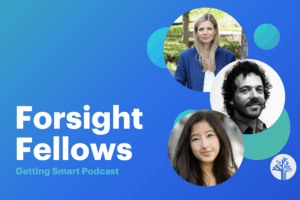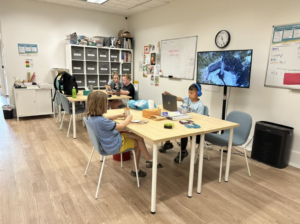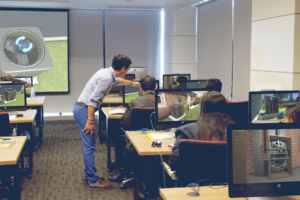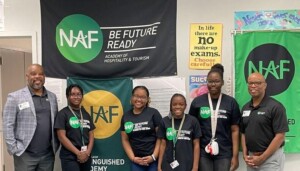Beth Anderson & Sarah Miller: Phoenix Charter Academy
By Chad Sansing
The Phoenix Charter Academy, a tuition-free, public high school in Chelsea,Massachusetts, that “actively recruits and graduates older, disconnected, and under-served adolescents” between the ages of 14 and 22. The school uses a mix of radical instructional differentiation and individualized personal support – including childcare – to ensure that its students meet its graduation requirements, which include a college-acceptance letter.
This is a long interview, so we will publish it in a series, starting today.
Beth Anderson, Executive Director, and Sarah Miller, Dean of Student and Family Support, share more of the school’s story, strategies, and challenges with Chad Sansing in the following interview.
Chad: What is the vision behind the Phoenix Charter Academy?
Sarah: With good teaching practices and proper support, all students – regardless of age and disconnection with school – can succeed through high school and become truly independent adults. This vision includes students left behind in other schools or communities.
Beth: Communities are able to create schools that serve the needs of all students so that they graduate into college or a training program that will give them the tools for a sustainable economic future. For me, the vision is about schools serving all students much better and starts with figuring out how to get highly disconnected adolescents into college.
What kinds of student thrive at the Academy?
Sarah: Students who need both academic supports that do not come in “traditional” schools and other types of [socio-emotional] supports in order to keep them connected to school. Students who are not ready to commit to what we do here have a harder time “sticking.” However, many students just need a different pathway to connect to schoo l- something new that hasn’t been offered – a different relationship to adults. Sometimes the commitment comes after this pathway is offered.
BA: Any student who will come to school consistently and wants to succeed. We help them figure out the rest.
How are traditional public schools under-serving your population?
Sarah: Many of our students need specific scaffolds that are not supported by big, comprehensive schools. So, in some classrooms this might mean 3 versions of Hamlet (one in Spanish, one in modern English, one “regular”). Most schools rely on “teach to the middle” tactics that don’t reach all learners and disable their higher-level thinking because they can’t access the text or material. By differentiating for understanding, we can push thinking further ahead. Further, for our students who have been out of school for a relatively long time, they end up with what I call “swiss cheese” gaps in their knowledge. This takes time to diagnose and is hard to differentiate for – I know some algebra and some geometry, for example. Large schools have a hard time working with this student to make sure all of his or her educational needs are being met. Others need more support. Others have never been part of a healthy adult relationship in other schools. Some just need a daycare for their kids.
BA: On a community level, traditional large urban high schools do not have an easy capacity to study and act on the needs of highly disconnected youth. I would argue that many are set up not to be able to do this. Union rules around teacher hiring, school day, academic program, etc., and top down budget management make it hard for teacher leaders and principals to design and implement preventive and intervention strategies for these students. Therefore, PCA[Phoenix Charter Academy] type students are often the first to give up and leave. I do think there are a lot of teachers and leaders who are genuinely interested in these students in district schools and want to serve them.
On a societal level, early education and middle school level interventions seem the name of the game in terms of focus, research, and funding right now, and that is disheartening for those wanting to work with older adolescents and help them to succeed academically. In urban areas, it feels like many high school aged students not achieving in regular education programs are shunted into myriad low expectation environments. PCA exists partially to show that adolescents, even 17 year olds who have been out of school, can and will achieve at high levels in an environment that holds them to high expectations. Perhaps if programs like this are successful, we can start evolving the way we do alternative and other programs for older under-achieving youth.
How does learning at the Academy look different for those students than it did at their base schools?
Sarah: Teachers are required to create trustworthy, valuable relationships with students. They are also required to differentiate and constantly self-reflect on their own practices in order to help students achieve. Sounds simple, but many schools don’t require this.
Beth: Teachers are evaluated against student achievement, measured in a variety of ways. If kids don’t do well, we don’t do well. Period.
How do you use differentiation and inquiry to meet the Academy’s high academic and civic expectations?
Sarah: Teachers are always teaching students at many different levels in one class. Our classes are not tracked. Even within “geometry”, students often exhibit swiss cheese-type gaps in knowledge- no two slices of cheese have the same holes. Teachers have to understand these needs and differentiate instruction in order to fill these. Teachers are taught how to best use differentiation and inquiry. Peer coaching and outside consultants help teachers understand what they’re doing well and where they might need to grow in order to reach all students
Typically, popular college prep programs seem to follow teacher-centered curriculum. How does the Phoenix Charter Academy accomplish its goals differently?
Sarah: Teachers all use the workshop model of teaching with mini-lesson and lots of student-centered work. We also rely on extra time and tutors to help us accomplish this. Extra time in school is also a simple idea that matters deeply to our work. Most of our students are very far behind their suburban peers. While teachers are largely in charge of creating their own curricula, [those curricula are] based on student data and end goals . . . that are student-centered.







Maria Baron
Sounds like a great place - but how does an older underserved adolescent with a baby in tow move from her home to Chelsea Mass?